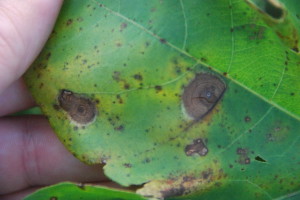COTTON DISEASE UPDATE: Leaf Spots on Cotton
go.ncsu.edu/readext?234584
en Español / em Português
El inglés es el idioma de control de esta página. En la medida en que haya algún conflicto entre la traducción al inglés y la traducción, el inglés prevalece.
Al hacer clic en el enlace de traducción se activa un servicio de traducción gratuito para convertir la página al español. Al igual que con cualquier traducción por Internet, la conversión no es sensible al contexto y puede que no traduzca el texto en su significado original. NC State Extension no garantiza la exactitud del texto traducido. Por favor, tenga en cuenta que algunas aplicaciones y/o servicios pueden no funcionar como se espera cuando se traducen.
Português
Inglês é o idioma de controle desta página. Na medida que haja algum conflito entre o texto original em Inglês e a tradução, o Inglês prevalece.
Ao clicar no link de tradução, um serviço gratuito de tradução será ativado para converter a página para o Português. Como em qualquer tradução pela internet, a conversão não é sensivel ao contexto e pode não ocorrer a tradução para o significado orginal. O serviço de Extensão da Carolina do Norte (NC State Extension) não garante a exatidão do texto traduzido. Por favor, observe que algumas funções ou serviços podem não funcionar como esperado após a tradução.
English
English is the controlling language of this page. To the extent there is any conflict between the English text and the translation, English controls.
Clicking on the translation link activates a free translation service to convert the page to Spanish. As with any Internet translation, the conversion is not context-sensitive and may not translate the text to its original meaning. NC State Extension does not guarantee the accuracy of the translated text. Please note that some applications and/or services may not function as expected when translated.
Collapse ▲ Steve Koenning, Extension Plant Pathologist and Keith Edmisten Cotton Extension Specialist
Steve Koenning, Extension Plant Pathologist and Keith Edmisten Cotton Extension Specialist
COTTON DISEASE UPDATE: Leaf spots on Cotton
Leaf spot on cotton is especially common throughout North Carolina A variety of fungi can be found in these spots including: Alternaria, Cercospora, Stemphyllium, and Colletrotrichum. Most commonly we are finding Ascochyta this year, which is not usually damaging to cotton. Though target spot has not been found on cotton in North Carolina at this date, it has been reported from Alabama, Georgia, and South Carolina. Fungicides can control these diseases, but rarely result in improved lint yield or quality. Furthermore, fungicides usually do not impact boll rot fungi.
Corynespora leaf spot or target spot of cotton was first identified as a possible problem in Georgia in 2005. In 2012, it was found in nearly all Georgia cotton fields and on rank cotton in North Carolina. The disease typically starts in the lower canopy where it causes 0.25 to 1 inch reddish-brown target spots with light and dark brown concentric bands or rings. Other fungi that can be associated with these spots include Stemphylium, Alternaria, Cercospora, and Colletotrichum. These fungi are most commonly associated with cotton under physiological stress or environmental factors such as frequent rainfall and overcast days.
Quadris and Headline are strobilurin type fungicides that can be applied to cotton and should provide control for ten days to two weeks. The Efficacy of other fungicides on cotton for control of this disease is not known, but many triazole fungicides have not proved to be very effective against this disease.


